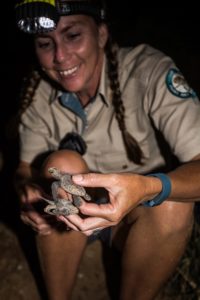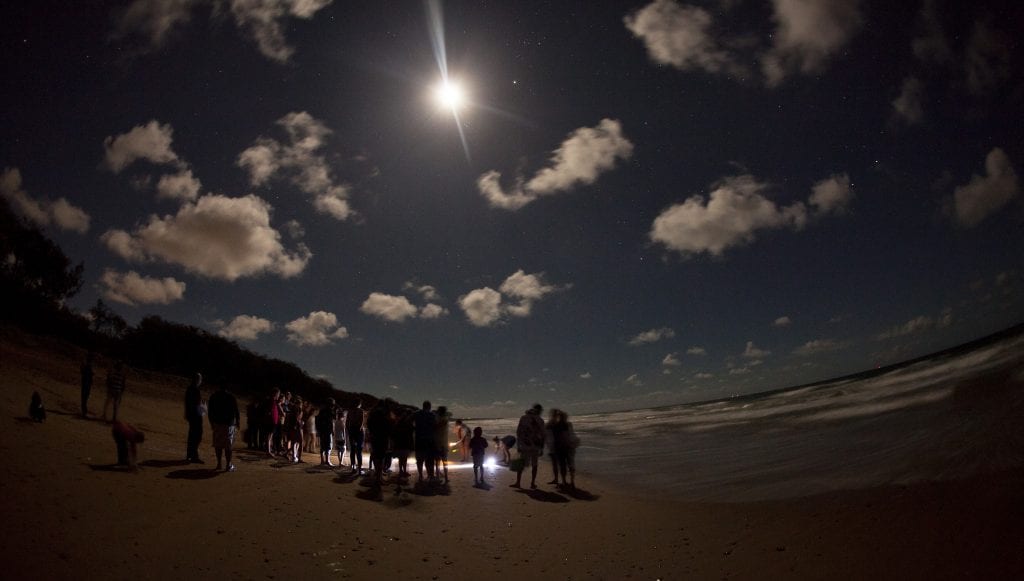Marine Protected Areas, National Parks, State Forests
Ranger Profile – Cathy Gatley

Cathy Gatley is Ranger-in-Charge of Mon Repos Conservation Park, just east of Bundaberg. Working with plants and animals is in her DNA…
Why did you decide to become a ranger?
My dad was a veterinarian who treated lots of native animals, so I was fortunate to grow up with koalas, gliders and birds around the house at various times. And my mum is very interested in native plants. So I think this is where my interest in working for the environment stemmed from. After working at the Queensland Museum in the visitor education section, and learning more about environmental management, I decided I wanted to become a Ranger.
How long have you worked in national parks?
I have worked as a Ranger for QPWS for 27 years.
Which parks have you worked in?
I have worked on the Atherton Tablelands, based at Crater Lakes National Park at Lake Eacham and working in surrounding parks. I’ve also worked in the Whitsunday Island National Parks and Woongarra Marine Park (now known as the Great Sandy Marine Park).
I am now based at Mon Repos Conservation Park. I’ve also been lucky to have worked in the field with marine turtles on Raine Island and Heron Island national parks and at Shoalwater Bay Conservation Park.
What is special about your current park?
Mon Repos is all about marine turtles, especially the endangered loggerhead turtle! It is also a park of the people – the community fought to have it declared as a park in the early days, and today many people work as volunteers, dedicating their time to help turtles and visitors.
Mon Repos is an excellent place to work because you get to work with an endangered species, doing hands-on conservation. In addition to this we also have the privilege of sharing our work with the thousands of people who visit the park each year. It is special to be able to help others connect with nature and make changes to help turtles survive.
(Mon Repos has a state-of-the-art Turtle Centre dedicated to marine turtle research, protection and education).
What is your most memorable moment as a ranger?
When I started at Mon Repos in 1996, our Chief Scientist, Dr Col Limpus, briefed the team about checking nesting turtles as they come ashore for ‘notches’ in their carapaces. This was part of a tagging program undertaken in 1975, where hatchlings were ‘tagged’ with notches before they headed out to sea. The study was designed to find out how old turtles were when they came back to shore to nest for the first time. In the early 2000s, I remember being behind a loggerhead turtle on the beach as she came ashore. I could see the scalloped notches on each side of her carapace and was immediately excited and hopeful. When the turtle had settled into nesting and I could turn on my light more fully, I could see this was an important turtle. Dr Col was in Brisbane at the time and I rang him from the beach. This turtle was the first of the 1975 turtles to return, she was 29 years old and nesting for the first time in her life!
What is the best part about working in a National Park?
Being in natural and beautiful places for ‘our office’ is so fortunate. At Mon Repos during the turtle season we get to spend a lot of time on the beach at night. So not only are we working with the animals, but we also get to see star-filled skies, beautiful orange moon rises above the ocean, meteors and, more often than you think, get soaked in a sudden downpour.
I think having the opportunity in my role to help others make a difference is one of the best parts about working in a park. We are generating change to make our world a better place.
What is your top tip for visitors to your park?
If coming for a Turtle Encounter tour, bring a crossword or a good book; turtles take their own time.
NPAQ thanks Cathy for taking time to answer our questions. We appreciate the work all QPWS rangers undertake in protecting Queensland’s national parks.


